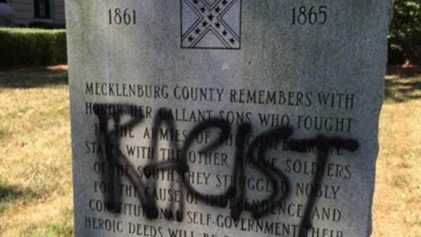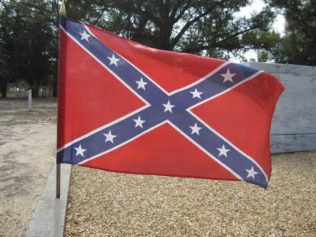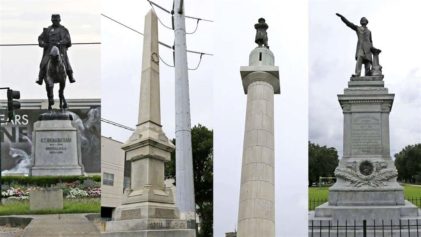
Neighbors watch as a team of Tulane University researchers use ground penetrating radar equipment on a piece of land that may hold a mass grave from a Reconstruction-era racial massacre in Thibodaux, La., Thursday, May 17, 2018. The results could indicate whether digging would likely turn up a mass grave where white mobs are said to have dumped the bodies of African-Americans they killed in 1887. (AP Photo/Gerald Herbert)
NEW ORLEANS (AP) — Researchers searching for a possible mass grave from a racial massacre in 1887 said they picked up signals last month of disturbed earth at a south Louisiana site, but they cautioned they don’t know yet what ground-penetrating radar detected.
The signals were detected Thursday, May 17, the first day of a survey of a vacant lot in the community of Thibodaux, where locals believe white mobs dumped the bodies of African-Americans killed during a Reconstruction-era rampage. The mobs were out to break a monthlong strike by sugar plantation field hands, many of them ex-slaves, in the era following the American civil war.
The experts were cautious as radar probed for underground disturbances warranting further investigation.
“I’m beginning to think we might have found a prospective site. But it might be from a garbage dump,” said Tulane University geophysics professor Cynthia Ebinger, who operated the radar at the location some 65 miles (95 kilometers) west of New Orleans
They received quick disappointment as a man who once lived across the street came to watch and told them a small oil rig once stood in the area they had marked by small orange flags.
Tulane anthropology graduate student Davette Gadison was in charge of the initial survey. Gadison had done past work with a forensic team unearthing remains of 20th-century civil war victims in Guatemala — and similar work in the East African region of Somaliland.
Ebinger said signals initially indicated a pit about 6 feet deep (2 meters) and 10 feet (3 meters) across in an area where locals believe victims could have been buried. An estimated 30 to 60 African-Americans are believed to have been killed in what became known as the “Thibodaux Massacre.”
“This is exciting,” said John DeSantis, who wrote a book on the massacre and helped form a committee of the victim’s descendants and others. He smiled broadly as Gadison showed him radar images on her cell phone.
But Sylvester Jackson, whose great-grandfather survived the rampage, came to watch and told them about the oil rig.
It was a bit deflating, Ebinger said.
Bones don’t show up on radar. The signals might show disturbed earth underground — areas where bodies could have been buried — or anything else, even garbage.
Ebinger operated controls of the radar — an instrument mounted on a pair of metal frames they slowly moved across the ground. Guided by a measuring tape, geophysicist Ryan Gallagher set the radar down every 25 centimeters (10 inches), saying “point, point, point” to indicate when Ebinger should trigger a radar signal.
An archaeology professor helped by extracting core samples from the soil with a long, narrow metal cylinder.
The work calls for finding evidence meriting further attention on land now owned by an American Legion chapter, built by African-American veterans during the segregated 1950s. The researchers weren’t immediately seeking human remains. If any bones are detected, they must immediately halt work and seek state permission to continue.
But after a full day Thursday, the researchers said they wouldn’t be returning Friday since they had to analyze the initial data.
Neighborhood residents and the commander of the American Legion post watched the work Thursday. The search was complicated by the fact that the American Legion post building was erected over what had become a city landfill for a time.
Post commander Deborah Winston said she first heard stories of a possible mass grave in the area before DeSantis began researching his book, since published in 2016.
She thought at first that people were telling ghost stories. She remembered telling them: ‘Y’all trying to scare me? I’m in the building by myself at night.”
“I feel better now, since they’re out here trying to find out what’s going on,” she said.
Events in 1887 began with striking sugar workers demanding a raise. According to DeSantis, they also wanted cash payment, instead of the chits they received for use only in a plantation company store. As tensions soared, a judge declared martial law in Thibodaux. When violence finally erupted on Nov. 23, 1887, white mobs went door-to-door for more than two hours shooting unarmed blacks, according to DeSantis.
A committee has been formed of descendants of the massacre’s victims, as well as descendants of Confederate and plantation families. If a mass grave is eventually discovered, DeSantis said, the committee would likely ask that remains be exhumed and reburied on consecrated ground.
Jackson, 86, said he hopes that eventually the remains will be found and identified.
“I want to be here when they dig up something, get the bones up. Do the DNA and we can have closure then,” he said.


